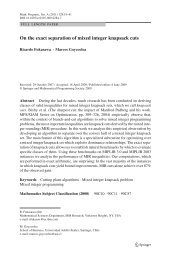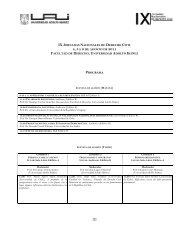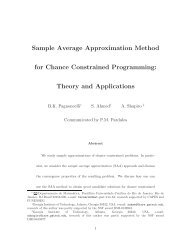Stability analysis of the oligopoly problem and variations Bernardo ...
Stability analysis of the oligopoly problem and variations Bernardo ...
Stability analysis of the oligopoly problem and variations Bernardo ...
Create successful ePaper yourself
Turn your PDF publications into a flip-book with our unique Google optimized e-Paper software.
5 The <strong>oligopoly</strong> <strong>problem</strong><br />
has <strong>the</strong> same spectrum <strong>of</strong> B. As <strong>the</strong> second matrix in this product is symmetric, we can use 2 to conclude that<br />
⎛<br />
⎞<br />
1 1/2 1/2<br />
S = ⎝ 1/2 1 1/2 ⎠<br />
1/2 1/2 1<br />
has <strong>the</strong> same signature <strong>of</strong> B. This matrix can be written as S = 1/2(U) + 1/2I <strong>and</strong> its spectrum is σ(S) = {1/2, 1/2, 2},<br />
which can be easily calculated following <strong>the</strong> same steps as in <strong>the</strong> (D,PM,L) case. We observe that in <strong>the</strong> n-dimensional case<br />
we have σ(S) = {1/2, . . ., 1/2, (n + 1)/2}. Remembering that B = −2A, we see that Σ(A) = (0, 3, 0) <strong>and</strong> hence <strong>the</strong><br />
system is stable for any adjustment constants α i , i = 1 . . .3.<br />
We note that Sylvester’s Law <strong>of</strong> Inertia 2 is a limited tool in <strong>the</strong> sense that it does not explicitly calculate any eigenvalue<br />
<strong>of</strong> A. It solely gives us <strong>the</strong> signature <strong>of</strong> <strong>the</strong> matrix, which in <strong>the</strong> continuous case describes <strong>the</strong> stability, provided that <strong>the</strong><br />
eigenvalues <strong>of</strong> <strong>the</strong> intermediate matrix (in our example it was matrix S) can be computed.<br />
(b) Computing <strong>the</strong> eigenvalues explicitly<br />
Now we study ano<strong>the</strong>r classical method <strong>of</strong> linear algebra that will enable us to calculate <strong>the</strong> eigenvalues <strong>of</strong> <strong>the</strong> matrices<br />
involved in <strong>the</strong> models. The method was developed by Shermann <strong>and</strong> Morrison <strong>and</strong> it is a technique to solve linear systems<br />
<strong>of</strong> equations. A good reference for <strong>the</strong> method is [3].<br />
Suppose we have a linear system Ax = b where A = B + u ⊗ v, B is a matrix whose inverse can be easily computed <strong>and</strong><br />
⊗ denotes tensor product, defined by u ⊗ v = uv T , where v T is <strong>the</strong> transpose <strong>of</strong> <strong>the</strong> vector v .Denoting by 〈u, v〉 <strong>the</strong> inner<br />
product u T v, one can proceed as follows:<br />
Ax = b ⇔ (B + u ⊗ v)x = b ⇔ Bx + uv T x = b<br />
⇔ Bx + u〈v, x〉 = b ⇔ x + B −1 u〈v, x〉 = B −1 b, (10)<br />
where we pre-multiplied <strong>the</strong> last equality by B −1 . We consider x <strong>and</strong> 〈v, x〉 as two different terms <strong>and</strong> solve for 〈v, x〉. Then<br />
we take <strong>the</strong> inner product with v at both sides to get<br />
〈v, x〉 + 〈v, B −1 u〉〈v, x〉 = 〈v, B −1 b〉<br />
⇒ 〈v, x〉 = 〈v, B−1 b〉<br />
1 + 〈v, B −1 u〉 .<br />
Substituting 〈v, x〉 on <strong>the</strong> second equation <strong>of</strong> (10) we can write <strong>the</strong> solution as<br />
x = B −1 b − B−1 u〈v, B −1 b〉<br />
1 + 〈v, B −1 u〉 . (11)<br />
Recalling that <strong>the</strong> inverse matrix B can be easily computed, we have obtained a solution without inverting <strong>the</strong> original matrix<br />
A, which could be hard to calculate.<br />
We are going to apply this method to obtain a numerical scheme to find all <strong>the</strong> eigenvalues <strong>of</strong> (D,PM,Q)-matrix below:<br />
⎛<br />
⎞<br />
0 −β 1 · · · −β 1<br />
−β 2 0 · · · −β 2<br />
A = ⎜<br />
⎝<br />
.<br />
. . ..<br />
⎟<br />
. ⎠ , (12)<br />
−β n −β n · · · 0<br />
where β i = 1/(2 + 2k i ). As before we go through <strong>the</strong> 3 × 3 case. We start by decomposing A as follows:<br />
A =<br />
=<br />
⎛<br />
⎝ 0 −β ⎞ ⎛<br />
1 −β 1<br />
−β 2 0 −β 2<br />
⎠ = ⎝ β ⎞ ⎛<br />
1 0 0<br />
0 β 2 0 ⎠ ⎝ 0<br />
−β 3 −β 3 0 0 0 β 3<br />
⎛ √ ⎞⎛<br />
√ ⎞⎛<br />
β1<br />
√<br />
0 0 β1<br />
√<br />
0 0<br />
⎝ 0 β2<br />
√<br />
0 ⎠⎝<br />
0 β2 0 ⎠<br />
√<br />
0 0 β3 0 0 β3<br />
⎛<br />
∼= ⎝<br />
√ ⎞⎛<br />
β1<br />
√<br />
0 0<br />
0 β2<br />
√<br />
0 ⎠⎝ 0<br />
0 0 β3<br />
−1 −1<br />
−1 0 −1<br />
−1 −1 0<br />
⎞⎛<br />
⎠⎝<br />
−1 −1<br />
−1 0 −1<br />
⎞<br />
⎠<br />
−1 −1 0<br />
⎝ 0 ⎞<br />
−1 −1<br />
−1 0 −1 ⎠<br />
−1 −1 0<br />
√ ⎞<br />
β1<br />
√<br />
0 0<br />
0 β2 0 ⎠<br />
√<br />
,<br />
0 0 β3<br />
Preprint MAT. 22/06, communicated on September 25 th , 2006 to <strong>the</strong> Department <strong>of</strong> Ma<strong>the</strong>matics, Pontifícia Universidade Católica — Rio de Janeiro,<br />
Brazil.

















